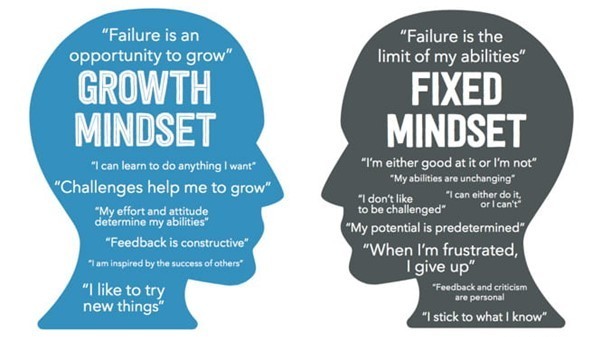The concept of Growth Mindset
7th February 2023
The concept of Growth Mindset was first developed by Carol Dweck in the 1980s. She argued that a person’s potential is not fixed but can be changed and developed through effort and perseverance.
Dweck believed that the key to success was embracing the idea of a Growth Mindset – the belief that individuals can improve their skills and abilities through effort and dedication.
Dweck’s research has been widely studied and utilised in many different contexts, with the most recent being in the field of organisational psychology. Growth Mindset thinking has been embraced by many organisations to foster employee engagement, performance and loyalty. It encourages employees to take ownership of their learning and development, while providing them with the opportunity to take risks, explore new ideas, and make mistakes (and learn from them). This type of thinking is seen as a more effective approach to managing employees and their performance.
Growth Mindset thinking has now become embedded in many of today’s workplaces, mixing in with workflow strategies such as Agile, where the focus is on both speed, micro-focused sprints and iterative delivery. It’s also central to Design Thinking, where in the notion of dissecting various experiences, workflows and processes to then prioritise broken aspects of those – with experimental design, relies heavily on a Growth Mindset that keeps our minds open to possibilities, exploration and careful but critical thinking.
It is a way of thinking that encourages employees to embrace continuous learning, growth, and development. This type of thinking is becoming prevalent in many disruptive and fast-growth unicorn companies who live by the Growth Mindset mentality every day to help them navigate with an optimistic, abundance-oriented approach to every problem they are seeking to solve.
In comparison to fixed mindset thinking, Growth Mindset thinking offers a more tolerant, exploratory and interactive approach to coaching employees and their performance.
Fixed mindset thinking, contrarily, focuses on the limitations of an individual’s skills and abilities. It assumes that a person’s potential is set and cannot be changed. It often manifests in biased reactions stemming mostly from False Attribution Error – where we presume the actions someone is taking are reflections of their personalities, not behaviours. This type of thinking can lead to employees feeling misunderstood and stagnant in every aspect of their daily interactions.
It dismantles intrinsic motivation, a sense of connection to the mission and identity with the overall mission.
We’ve all experienced Fixed Mindset encounters – where you were simply told that your research, idea or concept for addressing something was ill-fated, won’t work or possibly even foolish. Those with Fixed Mindsets aren’t evil in any way – but they have clearly learned that limited perspectives, right vs. wrong dichotomies and having a narrow frame of reference for all decision-making is a safter, more comfortable place to operate from.
Often those in roles that suit that sort of cognitive approach – such as accounting, finance, legal, compliance, and sadly often in Human Resources – can be often embracing a Fixed Mindset mentality.
But the best of our human experiences – both from an experience perspective as well as from a problem-solving one, have been when we were open-minded to the solution, were treated as a valued contributor and had a level of influence in developing the solution together with others.
Creating unique and inclusive cultural norms, whilst also remaining innovative, entrepreneurial and imaginative – often describes the most incredible success stories in our time.
Think Airbnb, Deliveroo, Uber, many B2B software companies reinventing business today, they all espouse a culture of creation, exploration and examination – to get to the right answers for their customers – not their egos.
I think Fixed Mindsets may have their place from time-to-time, particularly in areas where fast, hard and urgent decision-making in a crisis needs to be made. But the balance is shifting towards a more engaging and open approach to every day cognition and interaction – and it’s having a profound difference on what’s getting created, build and delivered – both inside and outside your company.
Growth Mindset thinking is focused on the possibilities of what an individual can achieve. It encourages employees to look for ways to develop and grow their skillset. It encourages employees to take risks and explore new ideas, recognising that mistakes are part of the learning process. By embracing Growth Mindset thinking, an organisation can foster a culture of learning and development.
This type of thinking can also help to improve employee engagement and loyalty. When employees feel their potential is being recognised and nurtured, they are more likely to stay with the organisation for the long haul.
Additionally, employees who are given the opportunity to grow and develop their skillset are more likely to take initiative and be creative in their roles. This can lead to increased productivity and better overall performance.
Growth Mindset cultures encourage employees to take ownership of their learning and development, while also providing them with the opportunity to try new things and explore new ideas. By taking this approach, HR and your company’s management can create a culture of learning and development that will ultimately lead to improved performance and better results.

Growth Mindset culture also helps to build trust and loyalty between employees and the organisation, when consistently applied across the daily interactions in your company.
When employees feel their hard work and dedication is appreciated, that mistakes are natural – and good if we learn from them, they are more likely to stay with the organisation.

By creating a culture of continuous improvement and learning & development, organisations can create an environment where employees feel valued, well-developed and appreciated. This can help to increase employee engagement and loyalty, resulting in improved retention rates.
It’s often very challenging to work in organisations where employees have become jaded, based on their experiences with management or leadership in the past. We are, as human beings, often hyper-vigilant when it comes to protecting our reputations, careers and livelihoods.
Thus the first thing that triggers us is a negative reaction to making a mistake, taking on problems that appear too difficult to solve, or being criticised (often openly) for not achieving goals the first time out.
That’s why leaders and managers need to really extend themselves, and check their reactions to such scenarios, as the last thing they want to do is create an overly cautious, nervous or trepidatious workforce.
Especially when innovation and creativity are the two leading advantages for any growing business.
Overall, fostering a Growth Mindset culture is a powerful retention tool. It encourages employees to take ownership of their learning and development and provides them with the opportunity to take risks and explore new ideas.
By taking this approach, leaders and managers can create a culture of learning and development that will ultimately lead to improved performance and better results.
It also becomes a viral attraction for potential new hires who haven’t yet heard of your brand – but who are very keen on finding a place with an open mind, a tolerance and supportive environment for learning – and importantly – a place where innovation and creativity are everything.
About the author
Written by Jeff Wellstead, Jeff is the Founder & CEO of Big Bear Partners, Ltd. (www.bigbearpartners.com 07921 888558), Please get in touch with Jeff if you’d like to discuss the themes from his article in more detail.
Share this post:



